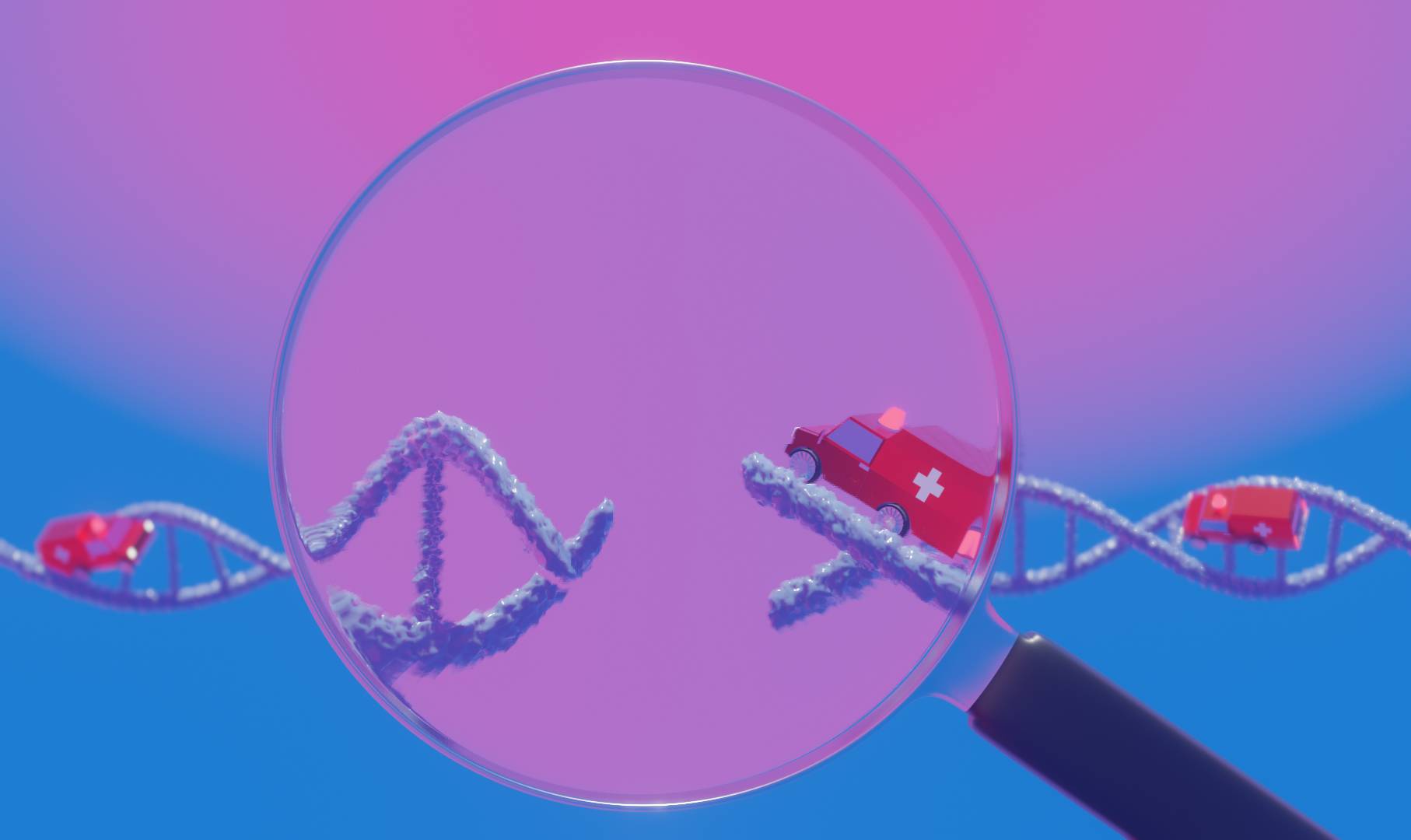The ability to edit the genome by altering the DNA sequence inside a living cell is powerful for research and holds enormous promise for the treatment of diseases. However, existing genome editing technologies frequently result in unwanted mutations or can fail to introduce any changes at all. These problems have kept the field from reaching its full potential.

Researchers led by Princeton's Britt Adamson have discovered a new tool to improve the CRISPR-Cas9 gene-editing method. They call it Repair-seq, represented here as a magnifying glass. Repair-seq allows researchers to quickly see how different genes involved in repairing DNA damage (ambulances) affect the accuracy and efficiency of genome editing technologies.
Now, research from the laboratory of Princeton's Britt Adamson, conducted together with collaborators led by Jonathan Weissman at MIT and Editas Medicine, details a novel method called Repair-seq that reveals how genome editing tools work.
"We've known for a long time that the mechanisms involved in fixing broken DNA are essential for genome editing because to change the sequence of DNA you first have to break it," said Adamson, senior author on the study and assistant professor in the Princeton Department of Molecular Biology. "But those processes are incredibly complex and thus often difficult to untangle."
To repair DNA, cells use many different mechanisms, each involving several genes working together in distinct pathways. Repair-seq allows researchers to probe the contribution of each of these pathways to DNA repair by profiling how observed mutations change when one of these factors is removed -- and to do this for hundreds of genes simultaneously.
This lets scientists ask basic questions about DNA repair biology, and investigate how DNA repair mechanisms impact genome editing technologies. Adamson and colleagues first applied their method to one of the most commonly used genome editing approaches, which employs the bacterial Cas9 nuclease to cut across both strands of the double-stranded DNA molecule, creating lesions called double-strand breaks.

"Editing with double-strand breaks has been the bread and butter of genome editing for a long time, but making intended changes without unwanted mutations has been an enormous challenge. We set out to understand the mechanisms behind as many of these mutation events as possible, figuring that this could help us optimize the system," Adamson said.
Led by first author Jeff Hussmann, a postdoctoral researcher in the laboratory of Jonathan Weissman, the team used the data from Repair-seq to map how different DNA repair pathways are linked to particular types of Cas9-induced mutations.
Hussmann's analysis detected pathways that were already known as well as new ones involved in the repair of double-strand breaks. It also highlighted the enormous complexity and myriad systems involved in double-strand break repair.
The deep set of data unearthed in this work is now posted on an online portal that others can use to interrogate DNA repair pathways or proteins.
Coincidentally, while these initial studies were being completed, a team led by David Liu at the Broad Institute of MIT and Harvard was developing a genome editing system called "prime editing" that doesn't rely on creating double-strand breaks. Prime editing typically has a low success rate, but Adamson and Hussmann reasoned that studying the DNA repair pathways involved in prime editing might help identify avenues for improvement, so they joined forces with Liu to investigate prime editing using Repair-seq.
"Working together was a huge benefit," said Adamson. "For us, it was a fantastic experience of collaborative and team-oriented science."
The collaborating researchers found that the ability to obtain intended edits with prime editing was affected by proteins in one repair pathway: the DNA mismatch repair pathway. They then showed that inhibiting or evading that pathway dramatically enhanced the efficiency and accuracy of prime editing outcomes - positioning prime editing to become a preeminent genome editing technology.
Importantly, this work also demonstrates how Repair-seq can be used to improve other genome-editing technologies.
Further demonstrating Repair-seq's utility, the collaborating researchers also applied it to a third genome editing system technology, also developed by Liu. Results from that study were recently published in Nature Biotechnology.
"Repair-seq is a beautiful marriage of technological savvy and biological insight," said John Doench, director of research and development in the Genetic Perturbation Program at the Broad Institute, who was not involved with the work.
"And for the work on prime editing, what a wonderful example of collaboration! Prime editors have often proven difficult to work with, and this paper starts to understand why, while also kickstarting novel solutions," he added.
"We see Repair-seq as a tool that allows you to take a detailed picture of what your editors are doing and then very quickly assess, 'Is this a landscape in which I can see my way through to design principles that will help improve the tool?'" Adamson said. "We are really excited to improve Repair-seq and explore its future applications."
"Mapping the genetic landscape of DNA double-strand break repair," by Jeffrey A. Hussmann, Jia Ling, Purnima Ravisankar, Jun Yan, Ann Cirincione, Albert Xu, Danny Simpson, Dian Yang, Anne Bothmer, Cecilia Cotta-Ramusino, Jonathan S. Weissman and Britt Adamson, was published in the October 20 issue of Cell (DOI: 10.1016/j.cell.2021.10.002). This research was supported by the National Institutes of Health under award numbers 1RM1HG009490 (J.S.W.), 1R35GM138167-01 (B.S.A.), 5P30CA072720-22 (B.S.A.), and T32HG003284 (Princeton QCB training grant). B.S.A. is supported by the Searle Scholars Program.
"Enhanced prime editing systems through identification and manipulation of cellular determinants of editing outcomes," by Peter J. Chen, Jeffrey A. Hussmann, Jun Yan, Friederike Knipping, Purnima Ravisankar, Pin-Fang Chen, Cidi Chen, James W. Nelson, Gregory A. Newby, Mustafa Sahin, Mark J. Osborn, Jonathan S. Weissman, Britt Adamson and David R. Liu, was published in the October 14 issue of Cell (DOI: 10.1016/j.cell.2021.09.018). In addition to the sources noted above, this research was supported by the Merkin Institute of Transformative Technologies in Healthcare, US NIH U01AI142756 and R01EB031172, the Loulou Foundation, and the Bill & Melinda Gates Foundation.






